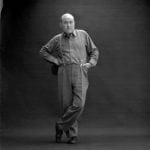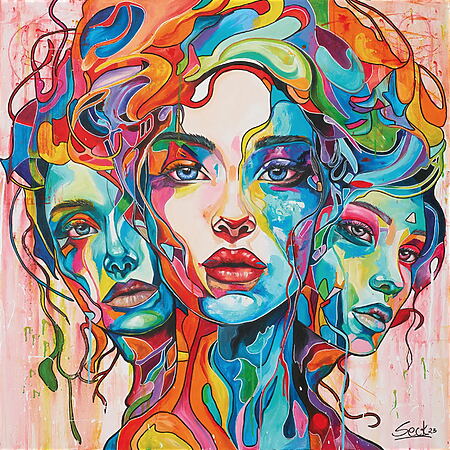If you click on "Wtawt" ("What the Artist Wants to Tell" or "What the artist wants to tell us"), you can expect fun. Pure fun, crazy fun, idiosyncratic fun - and yet again no fun, which does not require background knowledge. You can have fun without background knowledge with your dog on the playground, but even with the joyful interaction with another person, it would be good if you have an idea of what you are doing ...
And when WTAWT is about presenting the world's most famous paintings in a fun way, it can't be done without some background knowledge about these paintings. But don't worry, we'll keep it simple; most of the text is really just there to stimulate your imagination and, ideally, make you laugh occasionally.
This time, we'd like to introduce you to the work of an artist that became the most expensive work of art ever auctioned in the world on November 12, 2013. And since the highest prices for works of art these days are only achieved at auction, this work is currently the most expensive painting in the world.
With the following caveats: It's possible that another painting has already been auctioned for an even higher price. You'll soon find out when another article in the WTAWT category covers this very work of art. It's also possible that a mafia boss or a dictator who fled into exile with a great deal of his people's money paid even more for a work of art. Unfortunately, this (thank goodness) is outside our sphere of knowledge and therefore cannot be covered in the WTAWT category.
the most expensive painting in the world is by Francis Bacon. Who painted it, with what motif, and for what reason (and why is it so expensive)?
The painting was painted by Francis Bacon and depicts Lucian Freud three times, as it is a triptych. It is titled "Three Studies of Lucian Freud (Triptych)" and was painted by Francis Bacon in 1969. Forty-four years later, at the November 2013 auction at Christie's in New York, this triptych was auctioned for $142.4 million .
Francis Bacon (October 28, 1909 - April 28, 1992) is an Irish painter who developed into one of the most important painters of the 20th century in the time after World War II with growing international importance.
Francis Bacon painted this picture because he mainly deals with the representation of the human body in his (figurative) works, and it probably shows Lucian Freud because he had been friends with it for over two decades.

by Reginald Gray [CC-BY-SA-3.0], via Wikimedia Commons
Each single image of the triptych has the bacon-typical canvas size 198 x 147.5 cm, which it mostly used. The reason should have been that his studio did not allow greater dimensions. For every curious person, the question immediately arises as to why his studio did not allow a larger extent than 2 x 1.5 meters, Bacon certainly had most of his career over sufficient financial means to afford a generous studio.
A valid objection, a surprising answer: Bacon did indeed have a studio that was unsuitable for larger canvases for about 30 years (with interruptions). It was the upper floor of an old coach house in Reece Mews, in the London borough of South Kensington, with a narrow wooden staircase and tiny windows.
Bacon had made it really comfortable in this carriage studio, with a simple and modest living space and a tiny but totally focused studio room, which had a window on every side and a skylight. Almost chaotically full with work utensils and pictures, this small room in the middle offered just enough space for the easel with the picture on which Bacon was currently working, this working atmosphere is said to have promised him very much and spurred him on.
If the 147.5 cm is confused: the canvas measures 78 × 58 inches, a canvas common in the application area of this length unit, the crooked dimensions arise from the conversion, an inch is 2.54 cm. Incidentally, the canvas is 198.12 x 147.32 cm in size.
Like all of Bacon's paintings, the triptych, painted in oil, has no protective varnish coating, but is framed and glazed. As is often the case with Bacon, Lucian Freud, seated on a wooden chair in the center of the picture, is surrounded by cage-like linear constructions. These represent a kind of space within a space that excludes the viewer. Even though it is a triptych, this depiction, like all others by Francis Bacon, is not intended to tell a story. It simply shows Lucian Freud three times, without any relationship to one another, without any meaningful references or hint of a dramatic plot.

of Procsilas (Flickr) [CC-BY-2.0], via Wikimedia Commons
Bacon himself once said that he was brought up with the three-part images by the Cinemascope format of the wide wall cinema. Such an explanation is far too simple for some art scientists, they see a deeper meaning behind the three -part canvas and feel reminded of altarpieces with hinged wings.
A viewer of the picture that is not a preliminary educated also often considers why this work consists of three pictures, but he previously has to deal with some other thoughts about the "Lucian Freud", depending on his personal situation:
Alexander Steinfeld envisions the artwork as a three-part poster every time he trains on the complicated machine. It's designed to simultaneously target the quadratus lumborum, iliopsoas, rhomboid major, and latissimus dorsi. This is probably why it hangs twisted like a screw in the machine. Training the deep abdominal muscles, the latissimus dorsi, and the rhomboid major simultaneously must be almost impossible.
He would have also considered it possible that he would have to hang upside down and at a semi-oblique angle to train all those muscles at once; and he would have done just that if necessary, because if you want to look good, you have to put in the work.
The "Ultimate Workout" is the absolutely trendiest fitness club in Düsseldorf, and Alexander Steinfeld is happy that he gave access here through a business friend. Alexander Steinfeld always understood the poster as a usable incentive, even because of the physically well -trained and strong shape in the three pictures.
Having just heard that the original was auctioned for over $140 million, the motivation is even stronger. If it's possible to generate such revenue with a few such banal pictures, that's impressive. Moreover, for a good-looking person with a perfectly toned body, it's also possible to conquer the Olympus of the business world.
Alexander Steinfeld, as a motivational trainer, looks after other sizes of the business world, for € 85 per individual hour, € 2375 per seminar, he comes to a good € 15,000 net per month. But if you want to get high, of course, you also have to maintain a corresponding lifestyle ... Care is actually too much, your apartment is tiny and far out and no one gets to see it, but the office costs a lot, and the parties and the business lunches, and the clothes with the labels very specific brands, and the leasing-BMW also ... more than 5,000,- € are never actually left for it.
In a particularly nasty training sequence, he is misleading how long he would have to work until he was connected to the purchase price of the image, in Euro 106 million ... In the case of a complex, unfortunately no longer reaching everywhere with a 10 % interest, for the optimist of the highest realistic interest volume of around 4 %, or even longer, or much longer, then the sums are much slower - Alexander cravates, Alexander has lost the desire to calculate.
Although, Alexander Steinfeld thinks, and quickly raises high how much the 150 places in the studio according to the prospectus bring up. 350,- € a month x 150 training stations, are € 52,500 a month, € 630,000 a year, a much promising start, but that will only be almost 11 million in 30 years, at 10 %. But wait a minute, the 150 places have to be cleared every 2 hours, between 9 a.m. and 11 p.m., so there are 700 places of € 350 = € 245,000, € 2,940,000 a year.
Oh nonsense, they are not all completely occupied. But when he trains, it is always fully in the studio, and even if it is empty during the day, you can probably start from a 75 % booking, i.e. a good € 500, € 2,100,000. Of which they drink a bottle of Cristal in the lounge after the training, mostly two, for 345,- € and thus at least 180,- € profit, are 300 x 360,- (eating, etc. at all not calculated, the lounge is buzzing correctly), € 108,000 a month, € 1,296,000, + the € 2,100,000 = 3.4 million, are almost the 60 million Half still missing.
Such sales prices for pictures should simply be forbidden, and the painter could not have put this bill in the head in the dream, life is simply unfair, Alexander thinks and treats himself to four bottles of champagne in the course of the evening, with a very sweet but unfortunately also very thirsty mouse.
Nathalie Bruchmüller should give a presentation of Lucian Freud for her art studies and is currently looking at a representation of the triptych by clicking. She lets the picture work on her and wander freely.
Not exactly a flattering representation, Lucian Freud looks a bit like Rocky would have looked like if he hadn't defeated Ivan Drago. The face is an unarmed color porridge in all three pictures, was Lucian Freud (except for the inherited psychotherapeutically slightly confused look, which he bears in many photos), in contrast to Francis Bacon really good?
It was probably precisely that, a fellow student, especially in the breast tone of the conviction, explained that men were just as vain as women, especially artists and homosexuals, and maybe Bacon did not get on the fact that he was already gravely believing, while the 13 -year -old Freud did not even have a tender wrinkle on his face ... Bacon was able to paint the body positions from the wrist, on which she has been working in vain for over a year.
But still, Bacon and Freud were good friends, and why did Bacon paint a friend so much? Anyone who has friends who paint one in this way no longer needs enemies? Maybe Lucian Freud was an enthusiastic gambling as Bacon, and Bacon had debt with him that he wanted to "work through" with a portrait? But no, Bacon painted the first pictures with crushed faces around 1948.
And Lucian Freud was not only the grandchildren of Sigmund Freud (which probably spoils the fun anyway), he was also a very serious and very employed painter in 1969 that he would not be able to develop into one of the most respected portrait painters of the 20th century in England.
Freud was certainly a competitor to Bacon, and the two regularly portrayed each other during their more than 30-year friendship (which, contrary to popular belief, began as early as 1945) – until the necessarily more down-to-earth Bacon had had enough of the snobbish, high-society-loving Freud in the mid-1970s.
What is known about Bacon, however, was that he didn't care who actually sat before him. He was only concerned with depicting the body in pose, not with his model; he didn't want to portray it in a recognizable or realistic way. "The important thing for a painter is painting and nothing else," Bacon clarified shortly before his death in 1991.
So perhaps not an affront to a friend after all, and these squashed faces are actually faces that scream—hadn't Bacon been firmly committed to the scream since the early 1950s? With this late scream in the picture, at a time of agreement with Freud, did Bacon at least want to ironically suggest that he was, after all, the superior painter of the two? Or did he simply use his friend Lucian Freud to wring a scream out of him, with which he would crown his entire source studies on the scream?
Bacon dealt with texts and fragments around the screams, he was just as fascinated by Nicolas Poussin's "Bethlehemitian children's murder" as well as a stand photo from Sergei Eisenstein's film Panzerkreuzer Potemkin, which shows the nanny that is just getting into the eye.
He even created a collection of medical photos, from books and magazines, large -scale shots of distorted mouths, teeth and all possible mouth diseases. He is also said to have been impressed by Georges Battales article "La Bouche" (from 1930, in the magazine Documents), in which the mouth is revealed as the vehicles of the most important experiences of man, whether food or fluid, love or anger, pain or pleasure. If you see it that way, it may not be about Lucian Freud, but about the cry itself, anger or pain, fear or pleasure?
Nathalie shakes trouble. She simply cannot do anything with this picture, you are sure to be critical of life if you always do not know how to pay for your game debts and that too much alcohol doesn't make you happy is no secret.
Francis Bacon is said to have also experienced a lot of violence, from his father, from the insurgents of the Irish republican Sinn Féin movement (at that time the organization, also called the “political arm of the IRA,” was not yet a party) and probably also from his long-time friend, George Dyer, who was known to be as depressed as he was prone to violence.
But isn't there another way to process it? In Nathalie's opinion, the triptych is anything but Bacon's best painting, even apart from the fact that it creates a depressive mood in the viewer. Processing painful experiences is certainly good, but can't artists also offer their audience a little service and emphasize the more joyful side of life?
Perhaps the blog commentator is right, who recently smeared the triptych as a hasty smoke from three perspectives and is difficult to recognize from the ugly background color?
But he also considers Jean-Michel Basquiat's works to be mediocre sketches by a talented seven-year-old, and Mark Rothko's paintings to be boring, flattened Twinkies (small, oblong cream cakes). He believes Gerhard Richter Jackson Pollock's paintings as the result of warm-up exercises.
Harsh assessments, certainly not objectionable from the point of view of freedom of expression – if only this commentator did not simultaneously make it abundantly clear that he has not the slightest idea of art as a generator of ideas for a creative society (he interprets Warhol's "mediocre" work as unoriginal reproductions of advertisements, Lichtenstein's pictures as comic art, and he has only seen one of Jeff Koons' balloon dogs).
Even if you don't necessarily have to join in the jubilation of Christie's auctioneer Jussi Pylkkänen about the many bidders who are able to pay over 20 million for a painting, it is a bit like someone who cannot read calling a poem by Sappho unsuccessful because they don't like the look of the cola (rhythmic elementary units) used, or criticizing a poem by Baudelaire because it has too many verses.


















